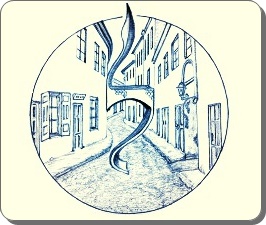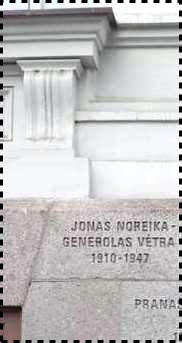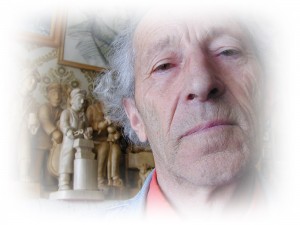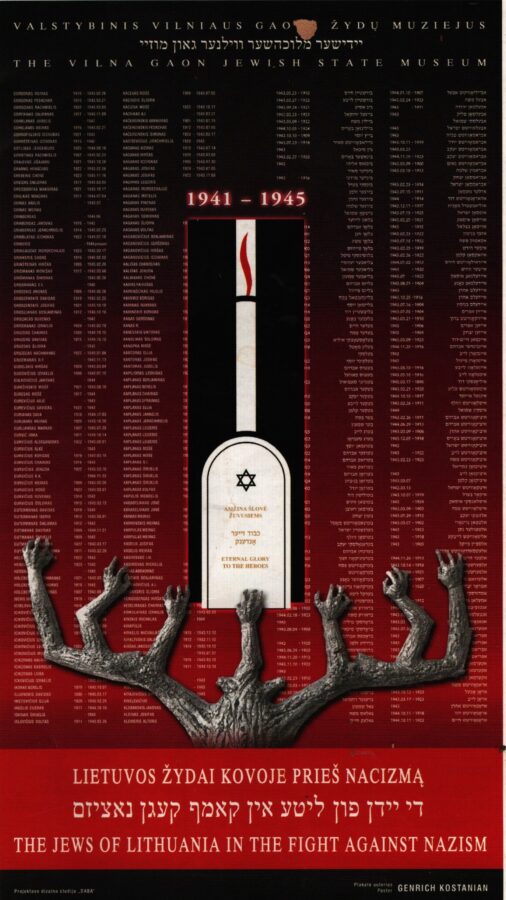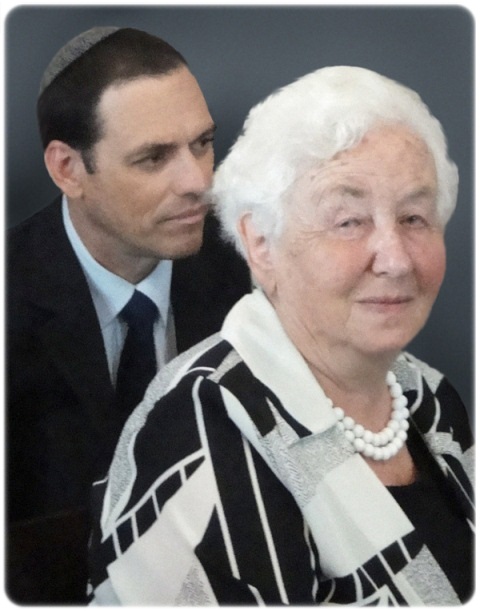Exotic Jewish Tourism
Vilnius Jewish Visitor Resources (Selection)
Antisemitism in the 21st Century Shtetl
OPINION | ANTISEMITISM | COMMEMORATIONS FOR DESTROYED COMMUNITIES
◊
by Dovid Katz
This article appeared today in ISGAP Flashpoint:
◊
The words “antisemitism in the shtetl” might evoke recollections of Fiddler on the Roof, a touch of family lore “from the old country” way back when, or for those familiar with modern Yiddish literature, a scene from this or that writer. Baffling as it may sound, however, it a substantial contemporary topic in the study of antisemitism, and, perhaps even more surprisingly, part of a phenomenon with implications for the future, given the vast number of cities, towns and villages in the world with a rich Jewish history but no living Jews, where potent anti-Jewish feeling (as well as pro-Jewish feeling) can be observed. As noted back in Flashpoint 21, antisemitism in Eastern Europe is very different from its much better known Western and Middle East incarnations.
READ MORE
New Jewish Monument in Rokiškis (Rákeshik), Lithuania, Commemorates 3 Synagogues
E V E N T S / O P I N I O N
by Dovid Katz
◊
For many years, international visitors to Rokiškis (in Yiddish: Rákishok, or less formally: Rákeshik), in northeastern Lithuania, have remarked that the town’s central area seemed to preserve little (or no) trace or commemoration of its erstwhile Jewish population, though a large monument now graces the entrance to the old Jewish cemetery outside town. Before the Holocaust, this town was home to around 3,500 Jews (some 40% of the total population, and the overwhelming majority in its central area). Luckily, a short film of pre-Holocaust Jewish Rákishok survives (from 1937), and is available on Youtube. Thanks to Polish film maker Tomek Wisniewski for circulating the link in recent days.
Grant Arthur Gochin in the Jerusalem Post on Memorials for Holocaust Perpetrator J. Noreika in Central Vilnius
Yankl-Yosl Bunk – Jakovas Bunka (1923 – 2014)
Yankl-Yosl Bunk (Jakovas Bunka), Famed Wood Sculptor, Last Jew of Plungyán (Plungė, Lithuania), Dies at 91
His Art Commemorates the Holocaust in Western Lithuania
Was World War II Red Army Veteran of the War Against Hitler
Exhibit Honoring Jewish World War II Veterans Disappears Into Vilnius Thin Air
O P I N I O N
by Dovid Katz
VILNIUS—Three Vilnius-based members of the Defending History team visited the Pylimo Street section of the Vilna Gaon Jewish State Museum of Lithuania this week, and asked to be shown the famous and widely admired exhibit honoring the Jewish veterans of the war against Hitler in Lithuania. The exhibit, titled Lithuania’s Jews in the Struggle Against Nazism, was opened in a spirit of unity, reconciliation and mutual respect, some fourteen years ago (PDF of the report in the Spring 2000 English edition of the Jewish community’s then quadrilingual newspaper, Jerusalem of Lithuania, which was edited by Milan Chersonski from 1999 until 2011; JPEG; reduced image below). Its primary creators are Joseph Levinson and Rachel Kostanian.
Fate of the Old Jewish Synagogue in Náyshtot-Távrik (Žemaičių Naumiestis); Updates to 6 February 2014
ניישטאָט⸗טאַווריק / Náyshtot-Távrik (Žemaičių Naumiestis):
A Municipality in Western Lithuania May Soon Demolish 1816 Synagogue Building
Samuel Gruber’s Report and Proposals
New Joseph Levinson Website Has Page on Old Jewish Cemeteries in Lithuania
The recently launched website JosephLevinson.com provides renewed opportunities for acquiring his two major books that are available in English. One, The Shoah in Lithuania, includes documents of the Lithuanian Activist Front detailing their intentions for Jewish citizens, issued before the outbreak of war on 22 June 1941. It is also rich in resources on understanding how, where and why the far right’s “Double Genocide” revisionism arose in the first place. These are just two of the many areas covered by the book.
Old Blood Libel Plaque Still Displayed, Without Comment, at Bernardinai Church in Vilnius
O P I N I O N
by Dovid Katz
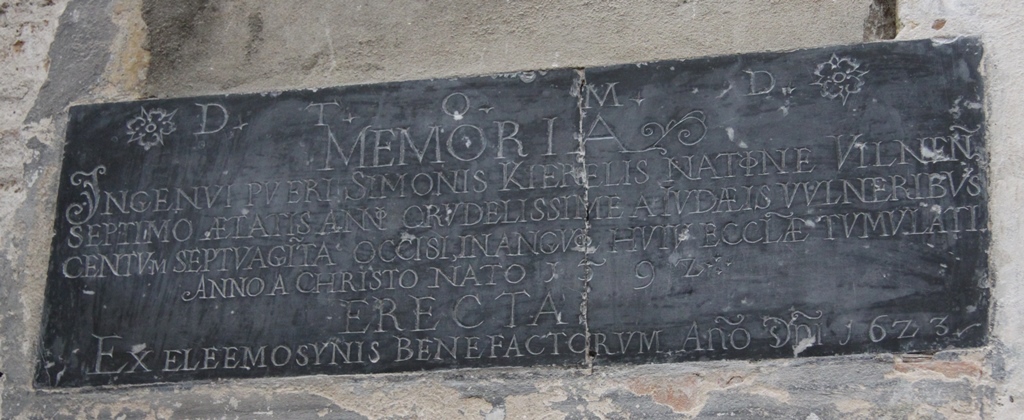
WHERE THE BLOOD LIBEL STILL STANDS: Seventeenth century plaque commemorating a seven year old allegedly killed by 170 Jewish-inflicted wounds, on display at Bernardinai Church, Maironio Street 10 in Vilnius
Where You Have to Step on Old Jewish Gravestones to go to Church
C E M E T E R I E S / C H R I S T I A N – J E W I S H R E L A T I O N S
by Dovid Katz
◊
The following are translated (and edited) excerpts from a longer letter in Yiddish received from a survivor who has asked to remain anonymous, about the Jewish gravestones that form the steps going up to the Reformed Evangelical Church at Pylimo 18 in Vilnius.
Never Have So Many Owed So Much to So Few: Reflections on an August 2013 Visit to Some Museums in Vilnius
O P I N I O N
by Roland Binet (Braine-l’Alleud/Belgium)
I recently returned home to Belgium from a visit to Vilnius, Lithuania. As is my custom, I visited different museums where the memory of the victims of the Holocaust is kept alive. I went first to the Green House on Pamenkalnio St 12. Not easy to find for foreigners as there are few indications on the streets. I also went to the Center for Tolerance. Apart from my wife and me there was no one else in either museum at the time of our visits there (in the high tourist season in August).
Mystery of the Eight-Pointed Western Litvak (Zámeter) Symbol on Jewish Gravestones
by Dovid Katz
On expeditions and on culture and history tours, we have on a number of occasions come across unusual Jewish gravestones (in Yiddish — matséyves), so far invariably on the territory of western Lithuania (and on occasion, in bordering Latvia) that is the land known in Litvak culture as Zámet (a Jewish person therefrom is a Zámeter, f. Zámeterin or deep Litvak Zámeterke).
In broad terms, it corresponds to historic Samogitia (Lithuanian Žemaitija). However, the specific cultural and linguistic borders relevant to Litvak culture and Yiddish dialectology often make for a unique Litvak geocultural configuration. For a general Yiddish orientation on the (pre-Holocaust) linguistic situation, see e.g. the maps for ‘ear’ and ‘dove’ vs ‘deaf’ in the in-progress Language Atlas of Lithuanian Yiddish.
Tourists Shocked at Monuments and Street Names for Holocaust Collaborators
Increasing numbers of summer tourists, in the spirit of “dark tourism” (and, in an EU/NATO country, a spirit of incredulity) are seeking out street names, public plaques, university lecture halls and other monuments to both collaborators and actual perpetrators of the Lithuanian Holocaust.
Some find the following sections helpful to locating specific sites:
(1) Anthology of street names and honors for killers and collaborators in Lithuania.
(2) Section on events and memorials for collaborators and perpetrators in various parts of Eastern Europe.
Would a Jewish Museum in Vilnius Graywash the Lithuanian Holocaust?
O P I N I O N
by Dovid Katz
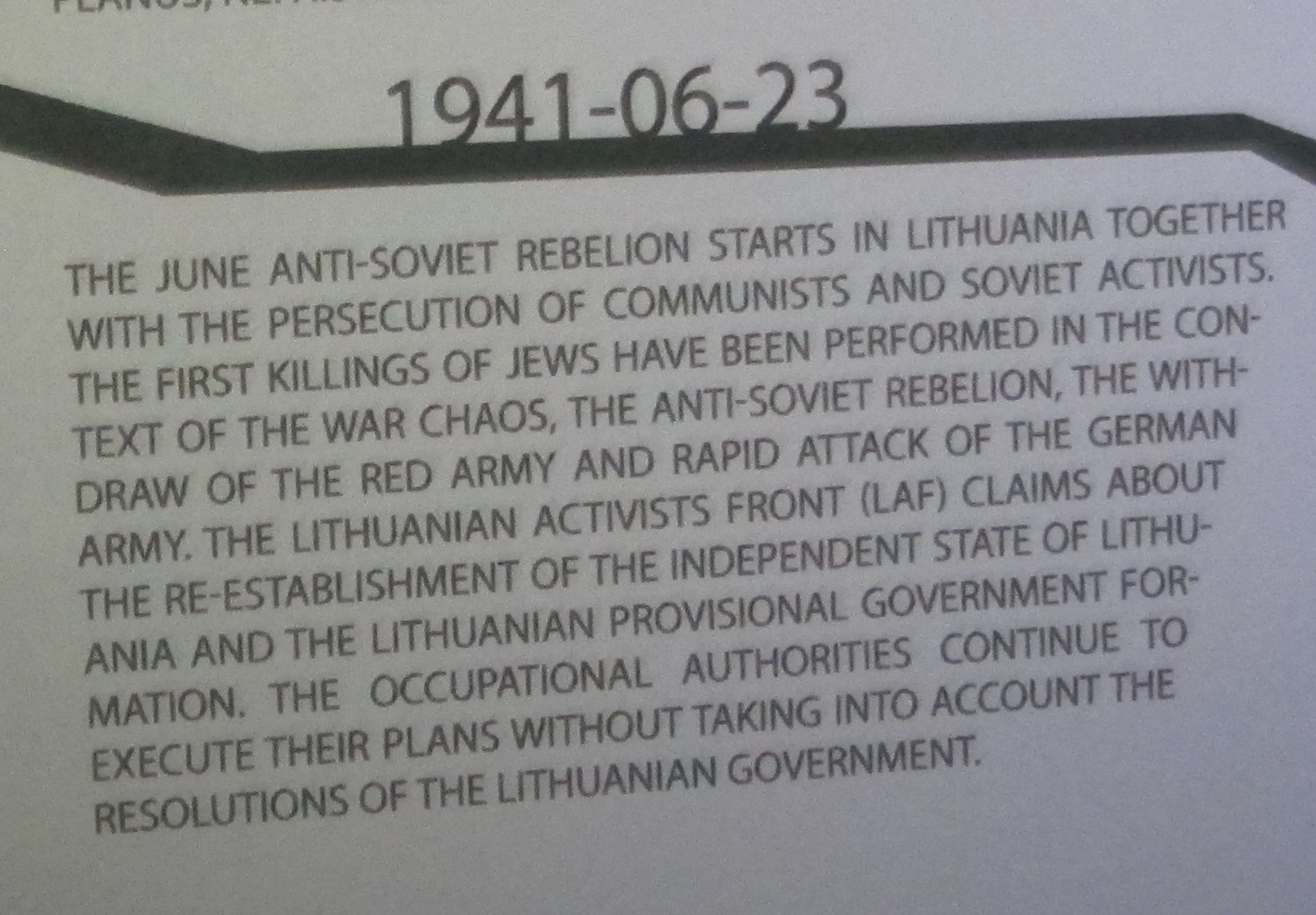
A recent visit to Vilnius’s “Jewish Museum — Tolerance Center” has revealed a shocking panel purporting to convey the “facts” of June 23rd 1941, the darkest date in Lithuanian Jewish history. It is the date on which the Holocaust in Lithuania began. No need, incidentally, to take our word for it. Ask any Lithuanian Jew, of any generation, current abode or political persuasion: When did the Holocaust in your country start?
Lithuanian Government’s 2013 Vilna Ghetto PR Jamboree
Vilna Ghetto is Back in Focus
But Will “Vilna Ghetto Fest” Include Public Apologies to Defamed Vilna (and Kovno) Ghetto Anti-Nazi Jewish Partisan Heroes? Invitations to Come Join the Party?
UPDATES:
1. The Secret “Big-Bucks Vilna Ghetto Disneyland Theme Park” Project (minus the Jewish community, minus apologies to the Partisans of Vilna, minus removals of memorials to local Holocaust perpetrators).
2. Renewed International Petition.
3. Ghetto survivors who joined the anti-Nazi resistance have been criminalized.
4. Government delegation in South Africa trying to pry Disneyland “investment” from unsuspecting South African Jews.
SEVEN SIMPLE SOLUTIONS
Strength Through Joy “Hitler Youth” Events Sponsored by the City of Vilnius on March 11, 2013
E Y E W I T N E S S R E P O R T / O P I N I O N
by Geoff Vasil
This March 11, the day in 1990 when the Supreme Soviet of the Lithuanian Soviet Socialist Republic declared Lithuania sovereign and separate from the Soviet Union, was celebrated in Vilnius in the usual manner: neo-Nazis, skinheads, their young and naive followers and a gaggle of elderly politicians—both serving MPs and has-beens—assembled and marched up the main boulevard chanting nationalist and anti-minority slogans, scaring children and generally making the streets unsafe for normal activities.
Shock of 2012: 1941 Nazi Puppet Prime Minister Reburied with Full Honors
Compiled by Dovid Katz
◊
EU/NATO Ally Honors Holocaust Collaborator; Lithuanian Jewish Community Issues Protest; 3 US Congressmen Write to Prime Minister
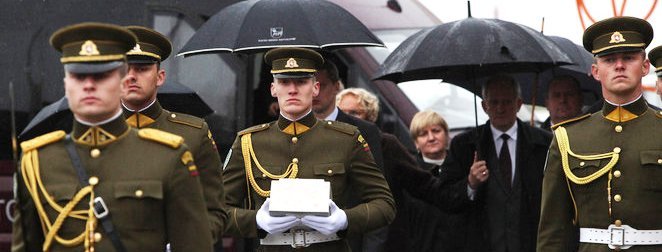 Remains of 1941 fascist leader Juozas Ambrazevičius (Brazaitis) met by honor guard at Vilnius Airport on 17 May 2012 and reburied in Kaunas’s Church of the Resurrection on the 20th, as city’s mayor dismisses criticism.
Remains of 1941 fascist leader Juozas Ambrazevičius (Brazaitis) met by honor guard at Vilnius Airport on 17 May 2012 and reburied in Kaunas’s Church of the Resurrection on the 20th, as city’s mayor dismisses criticism.
Office of the prime minister, who signed off on government funding (€8,700 / US $11,000), defends reburial & honors of the 1941 Nazi puppet “prime minister” who personally signed the protocols confirming Nazi orders for (1) “all means” against Jews (but avoiding executions in public); (2) setting up a concentration camp for Lithuanian Jews [euphemism for the carnage underway at the Seventh Fort]; (3) all Kaunas Jews to be herded into a ghetto within 4 weeks (English here).
SEE ALSO:
Collaborators Glorified section
Previous sanitization program
Dark Tourism: Memorials to Holocaust Perpetrators
The page has moved here.
The new URL is:
https://defendinghistory.com/memorials-to-holocaust-collaborators-in-public-spaces-and-state-sponsored-institutions-in-lithuania
Apologies for any inconvenience.
The Genocide Center
This page has moved here.
The new URL is:
https://defendinghistory.com/the-genocide-center
Apologies for any inconvenience
Lithuania’s Last Jewish Fort
This page has moved here.
The new URL is:
https://defendinghistory.com/the-last-jewish-fort
Apologies for any inconvenience.
